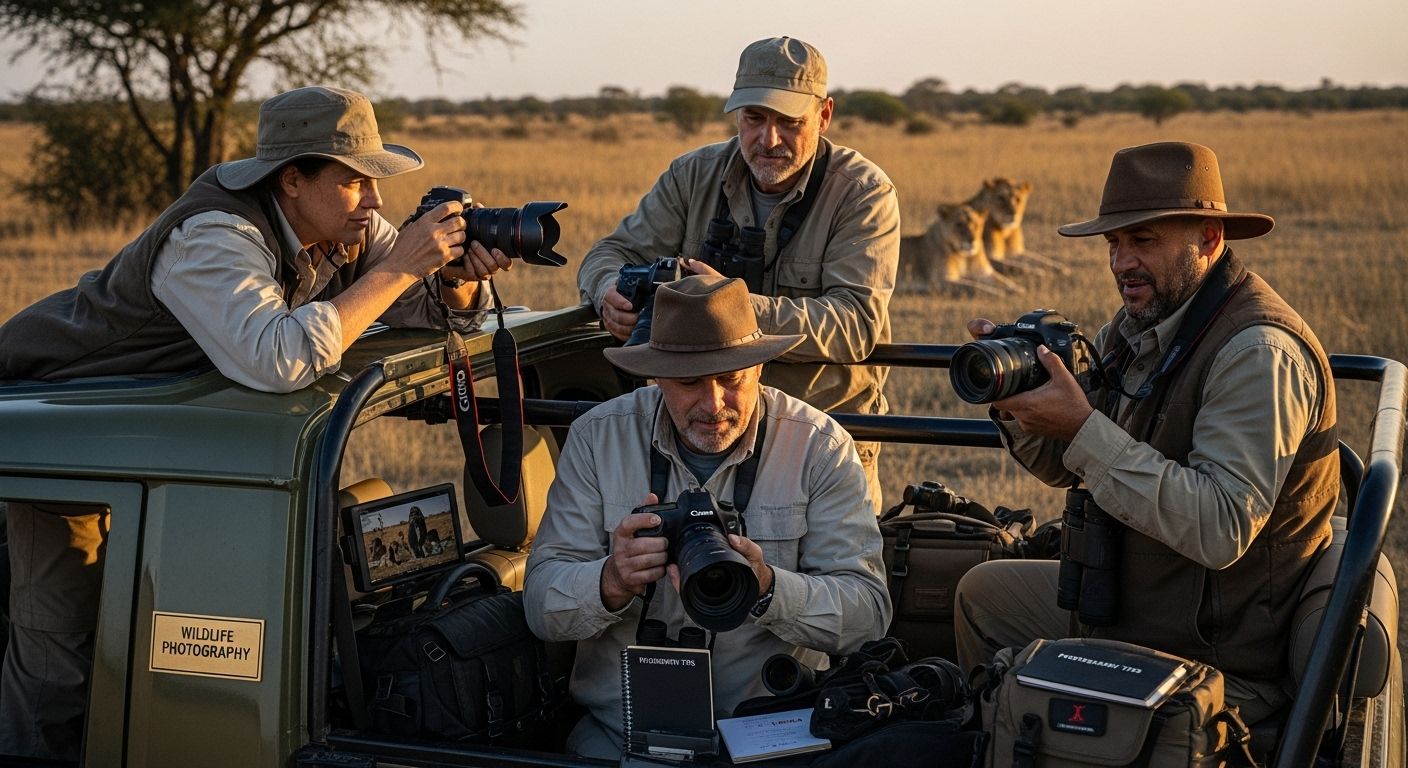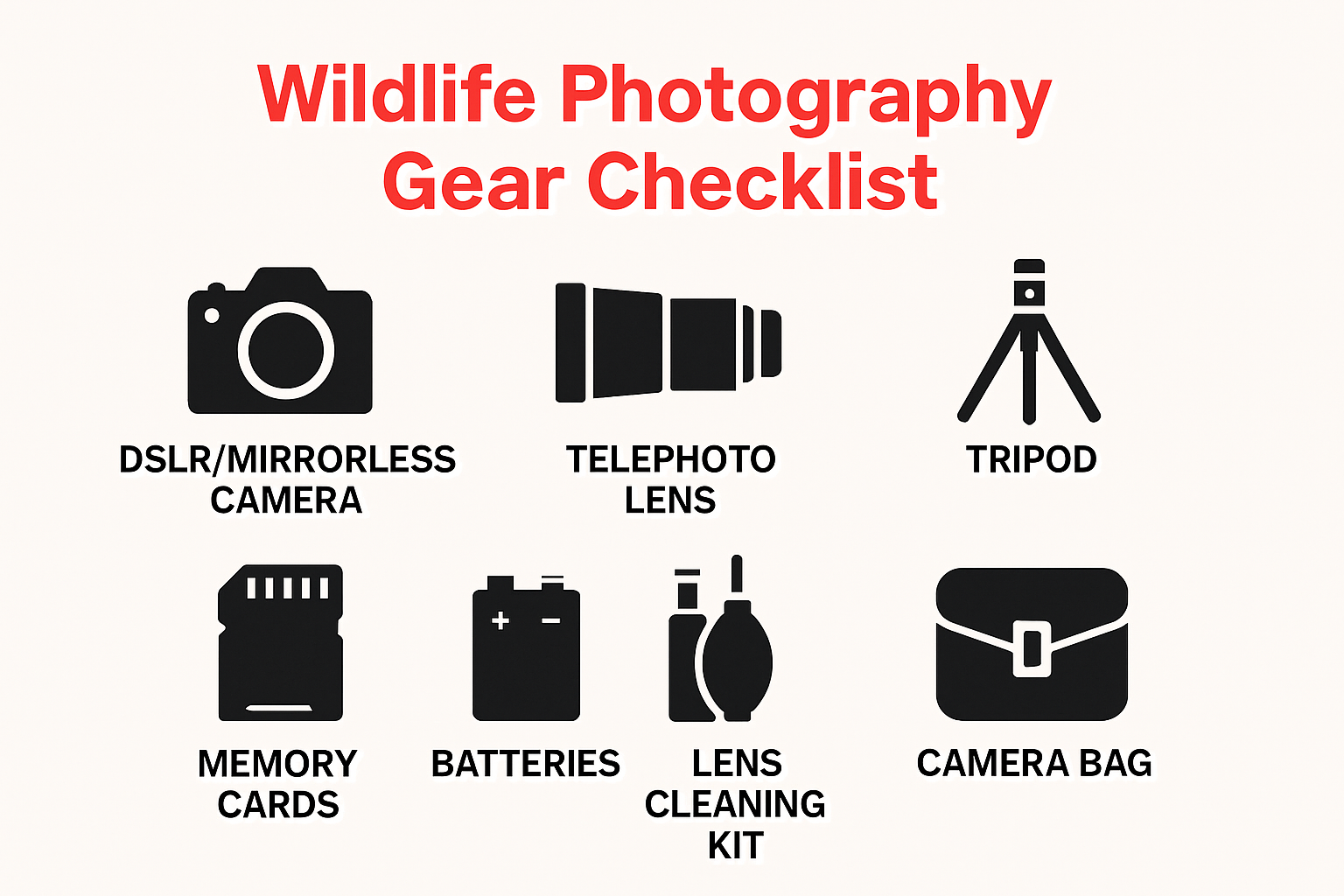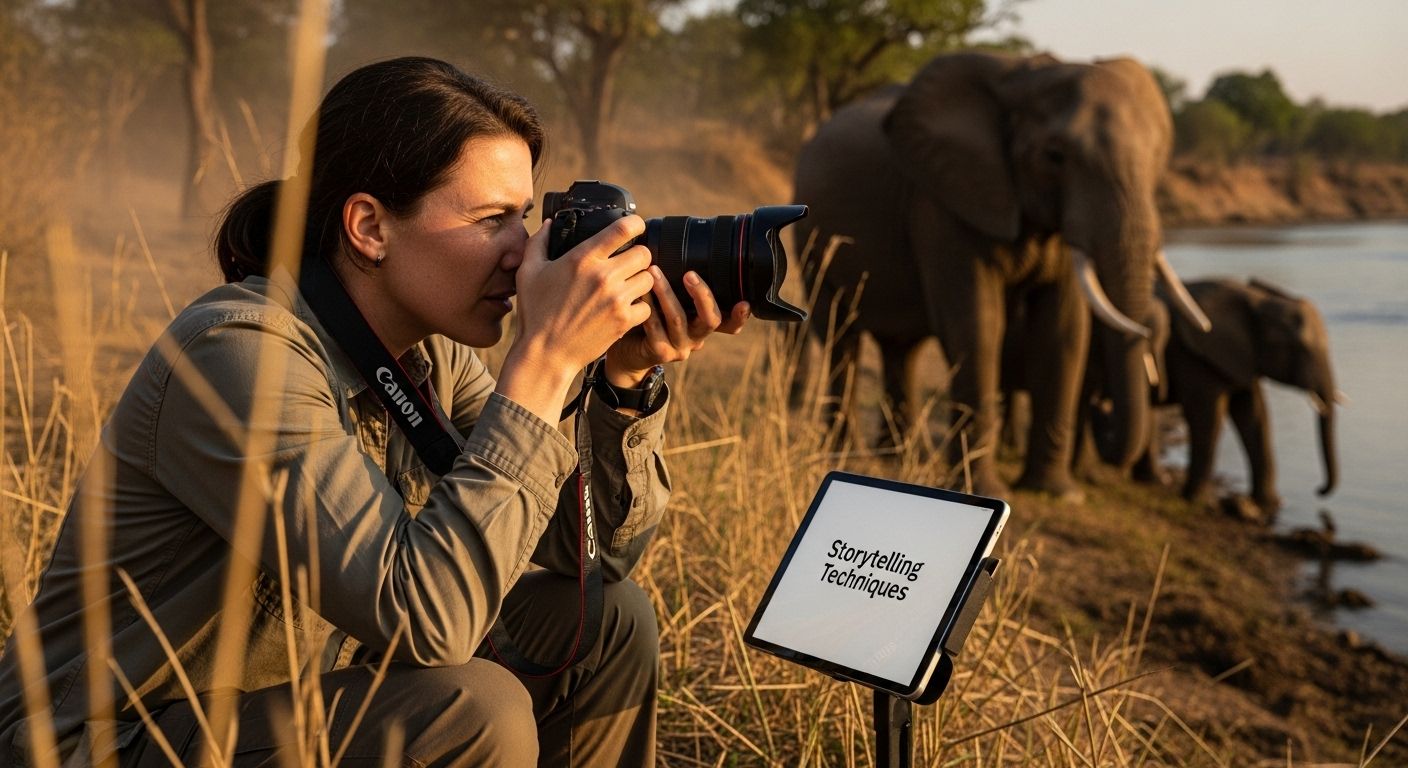Wildlife Photography Tips for Adventurers and Safari Travellers
Full Disclosure: Our AI Assistant Writes These!
While we're out in the bush tracking leopards, dodging elephants, and trying to get the perfect sunset shot, our trusty AI companion is back at camp, diligently crafting these blog posts. Don't worry though - it's been trained on years of real safari experiences and only occasionally suggests that tourists should pet the lions. (Please don't pet the lions. The AI was joking. We hope.)
The real reason? SEO loves fresh content, and we love fresh adventures. So while our AI handles the keywords and search rankings, we're out there finding the next hidden waterhole, secret viewpoint, or that one tree where the leopards always hang out. Win-win, really!
Wildlife Photography Tips for Adventurers and Safari Travellers

Wildlife photography calls for grit, patience, and a keen eye – especially if you dream of nabbing that once-in-a-lifetime animal shot on safari or in the bush. Cameras keep getting better and the choice of gear can be dizzying, but even with all the tech in your camera bag, you could miss the moment. The real trick? Nearly 80 percent of top wildlife photos depend on knowing animal behaviour and planning ahead, not just camera specs. This flips the script for any traveller who thought it was all about expensive lenses.
Table of Contents
- Choosing The Right Gear For Wildlife Shots
- Planning Your Wildlife Photography Adventure
- Techniques For Capturing Unique Animal Moments
- Staying Safe And Respectful In The Wild
Quick Summary
| Takeaway | Explanation |
|---|---|
| Choose the right camera gear | Invest in a digital SLR or mirrorless camera with a telephoto lens between 100-400mm for effective wildlife photography. |
| Research animal behaviors and locations | Understand wildlife patterns and habitats to anticipate photographic opportunities and improve shot quality during expeditions. |
| Use ethical practices in photography | Maintain a respectful distance from wildlife and avoid disruptive actions to ensure animal welfare and natural behaviors are preserved. |
| Plan logistics ahead of time | Create a flexible itinerary that incorporates local insights, guides, and buffer time to accommodate the unpredictable nature of wildlife. |
| Master your camera’s settings | Familiarize yourself with exposure, shutter speed, and ISO adjustments to effectively capture dynamic wildlife moments under varying conditions. |
Choosing the Right Gear for Wildlife Shots
Wildlife photography demands specialized equipment that can capture incredible moments in challenging outdoor environments. Selecting the right gear is not just about having expensive cameras but understanding how specific equipment enhances your ability to document wildlife with precision and creativity.
Camera and Lens Selection
Your primary tool for wildlife photography is a camera system capable of handling unpredictable and fast-moving subjects. The U.S. Forest Service recommends using a digital SLR with a telephoto lens in the 100-400mm range, which provides the flexibility to capture distant animals without disturbing their natural behavior. Professional wildlife photographers typically invest in full-frame cameras with robust autofocus systems that can track movement quickly and accurately.
Consider cameras with high burst rates (at least 7-10 frames per second) to capture split-second actions like a cheetah chasing prey or a bird mid-flight. Weather-sealed bodies are crucial for protecting your equipment in dusty, humid, or unpredictable safari environments. Mirrorless cameras have also gained popularity due to their lighter weight and advanced tracking capabilities.
Essential Accessories for Wildlife Photography
Beyond the camera body and lens, several accessories can dramatically improve your wildlife photography experience. A sturdy tripod is indispensable for maintaining image stability, especially when using heavy telephoto lenses. Look for lightweight carbon fiber tripods that offer durability without adding significant weight to your travel gear.
Additional critical accessories include extra batteries, multiple memory cards, lens cleaning equipment, and protective cases. Consider investing in a solid camera bag designed for outdoor environments that can protect your gear from dust, moisture, and potential impacts. Explore our detailed safari packing guide for comprehensive equipment recommendations.
To help you select and prepare the right gear for your wildlife adventure, here’s a summary of essential equipment and its purpose in the field:
| Item | Purpose/Benefit |
|---|---|
| Digital SLR/Mirrorless Camera | High burst rate and reliable autofocus for fast action shots |
| Telephoto Lens (100-600mm) | Capture animals at a distance without disturbance |
| Sturdy Tripod | Maintains image stability with heavy lenses |
| Extra Batteries | Ensures sufficient power for long excursions |
| Multiple Memory Cards | Prevents loss of opportunities due to storage limits |
| Lens Cleaning Equipment | Keeps optics clear in dusty or humid environments |
| Weather-Sealed Camera Bag | Protects gear from the elements during travel |

Lens Choice and Focal Length Considerations
Choosing the right lens is perhaps the most critical decision for wildlife photographers. Telephoto lenses with focal lengths between 200-600mm allow you to capture intimate wildlife moments from a safe and respectful distance. Prime lenses often provide superior image quality and wider maximum apertures, which are excellent for low-light conditions during dawn and dusk.
Image stabilization technology becomes crucial when working with longer focal lengths. Lenses with built-in stabilization can help you capture sharp images even when shooting handheld or in challenging lighting conditions. Wide-aperture telephoto lenses (f/2.8 or f/4) provide better performance in low light and create beautiful background blur that isolates your subject.
Remember that wildlife photography is as much about patience and technique as it is about equipment. While having professional-grade gear helps, developing your skills in composition, understanding animal behavior, and mastering your camera’s settings will ultimately determine the quality of your wildlife photographs.
Planning Your Wildlife Photography Adventure
Successful wildlife photography is more than just having top-tier equipment. It requires meticulous planning, strategic preparation, and a deep understanding of the environment you will be exploring. The U.S. Forest Service emphasizes the importance of comprehensive preparation before embarking on a wildlife photography expedition.
Understanding Wildlife and Location Dynamics
Before setting out on your adventure, conduct thorough research about the specific habitats and wildlife you intend to photograph. Each ecosystem presents unique challenges and opportunities. Understanding animal behavior patterns, migration routes, and seasonal variations can significantly improve your chances of capturing extraordinary moments. Wildlife photographers must become students of the environments they wish to document.
Research local weather conditions, sunrise and sunset times, and potential seasonal variations that might impact wildlife activity. Some regions experience dramatic shifts in animal movements during different times of the year. For instance, certain bird species migrate seasonally, while large mammals like elephants follow specific water sources during dry seasons. This knowledge allows you to plan your photography sessions with precision.
Ethical Preparation and Safety Considerations
Ethical wildlife photography goes beyond technical skills. It requires a profound respect for animal habitats and minimal intrusion. Always maintain a safe and respectful distance from wildlife, using telephoto lenses to capture intimate moments without disturbing natural behaviors. Check out our comprehensive safari booking guide for additional insights into responsible wildlife interaction.
Prioritize personal safety and environmental preservation. This means understanding local regulations, obtaining necessary permits, and following guidelines set by conservation authorities. Pack appropriate protective gear, including sun protection, insect repellent, and clothing that allows you to blend into the environment without startling wildlife.
Strategic Trip Planning and Logistics
Effective wildlife photography requires strategic logistical planning. Select destinations known for rich biodiversity and opportunities for wildlife encounters. Consider factors like accessibility, local photography regulations, and the presence of experienced guides who understand animal behaviors and local ecosystems.
Create a flexible itinerary that allows for unexpected opportunities. Wildlife photography is inherently unpredictable, so build buffer time into your schedule. Choose accommodations near wildlife-rich areas and consider working with local guides who have intimate knowledge of animal movements and hidden photography spots.
Remember that patience is your most valuable asset in wildlife photography. Sometimes capturing a single extraordinary image might require hours of waiting and observing. Develop a mindset of quiet anticipation, remaining alert and ready while respecting the natural rhythms of the wildlife around you. Your most memorable photographs will often emerge from moments of stillness and careful observation.
Planning a successful wildlife photography trip involves several key steps. Here is an overview of the recommended process to help you make the most of your adventure:
| Step | Description |
|---|---|
| Research Wildlife & Habitats | Understand target species, behaviour, migration routes and local ecosystems |
| Study Weather & Seasons | Monitor climate, sunrise/sunset, and seasonal animal movements |
| Prepare Ethically & Safely | Learn local regulations, obtain permits, pack suitable clothing and sun protection |
| Organise Gear & Accessories | Double-check camera equipment, tripods, batteries, and memory cards |
| Plan Flexible Itinerary | Allow for buffer time and unpredictable wildlife activity |
| Collaborate with Local Guides | Benefit from their expertise in animal behaviour and secret locations |
Ultimately, successful wildlife photography is a blend of technical skill, deep ecological understanding, ethical considerations, and an unwavering passion for capturing the raw beauty of the natural world. Each expedition is a unique journey of discovery, offering photographers a glimpse into the intricate and magnificent lives of wildlife in their most authentic environments.
Techniques for Capturing Unique Animal Moments
Wildlife photography transcends technical equipment and requires a sophisticated understanding of animal behavior, photographic composition, and storytelling through imagery. Capturing truly remarkable wildlife moments demands more than just pointing a camera at an animal – it requires patience, anticipation, and a nuanced approach to visual storytelling.
Understanding Animal Behavior and Anticipation
Successful wildlife photographers develop an almost intuitive understanding of animal behavior. This skill allows them to predict potential moments before they occur, positioning themselves strategically to capture extraordinary interactions.
Watch for subtle behavioral cues that signal impending action: a predator’s slight muscle tension before a hunt, a bird’s posture before taking flight, or a young animal’s playful movements.
Study animal patterns and social dynamics within different species. Each group has unique communication methods and behavioral rhythms. For instance, predators like lions have complex social structures where interactions between pride members can create compelling photographic narratives. Explore our guide on rare African wildlife species to understand the intricate behaviors of different animals.
Composition and Storytelling Techniques
Composition is the heart of powerful wildlife photography. Move beyond simple documentary shots and aim to create images that tell a story. Use techniques like the rule of thirds, leading lines, and negative space to create visually compelling narratives. Consider the background as critically as the subject – a well-chosen backdrop can transform an ordinary wildlife shot into an extraordinary piece of visual art.
Experiment with different perspectives. Get low to the ground for an eye-level view that creates intimacy with your subject. Use wide-angle lenses to capture animals in their expansive environments, showing their relationship with the landscape. Alternatively, tight telephoto shots can reveal intricate details like the texture of fur, the gleam in an eye, or the subtle interactions between animals.
Technical Approaches to Dynamic Wildlife Photography
Mastering technical skills is crucial for capturing unpredictable wildlife moments. Use continuous autofocus modes that can track moving subjects, and select burst shooting to increase your chances of capturing split-second actions. Understanding your camera’s settings becomes paramount – quick adjustments in exposure, shutter speed, and ISO can mean the difference between a blurred image and a razor-sharp capture of a fleeting moment.
Consider the light and time of day. Early morning and late afternoon provide softer, more dramatic lighting conditions that can dramatically enhance wildlife photographs. During these golden hours, sunlight creates warm tones and long shadows that add depth and emotion to your images. Backlighting can create stunning silhouettes, while side lighting can reveal intricate textures and details.
Remember that wildlife photography is a continuous learning process. Each expedition offers new challenges and opportunities to refine your skills. Embrace failures as learning experiences, study your images critically, and continuously adapt your techniques. The most compelling wildlife photographs emerge not just from technical proficiency, but from a profound respect and wonder for the natural world.
Ultimately, great wildlife photography is about connection – connecting with the environment, understanding animal behaviors, and communicating the intricate, beautiful stories of wild creatures through your lens. It is a powerful medium that can inspire conservation, raise awareness, and help viewers appreciate the complex, magnificent world beyond human experience.
Staying Safe and Respectful in the Wild
Wildlife photography is an extraordinary pursuit that demands more than technical skills – it requires a profound commitment to personal safety and environmental respect. The U.S. Forest Service emphasizes the critical importance of using common sense and understanding animal behaviors to ensure both photographer and wildlife remain unharmed.
Understanding Animal Proximity and Behavioral Cues
Maintaining a safe distance from wildlife is paramount. The Washington Department of Fish & Wildlife recommends using the ‘rule of thumb’ technique: extend your arm, give a thumbs-up, and if your thumb completely covers the animal, you are at a safe viewing distance. This simple method helps prevent potentially dangerous encounters while preserving the natural behavior of animals.
Learn to read animal body language and warning signs. Different species communicate stress or potential aggression through specific signals. For predators like lions or leopards, raised hackles, direct staring, or a twitching tail can indicate potential threat. For herbivores such as elephants or buffalo, ears spread wide or a lowered head might signal imminent defensive action. Check out our comprehensive safari safety guide for more detailed insights into animal behavior and interaction protocols.
Ethical Photography and Conservation Principles
Ethical wildlife photography goes far beyond personal safety – it is about preserving the integrity of natural ecosystems. Never manipulate an environment or disturb wildlife to get a photograph. Avoid using calls or sounds that might disrupt natural behaviors, and never feed animals to attract them closer. These actions can cause significant stress and potentially alter critical survival behaviors.
The U.S. National Park Service advises photographers to be patient and observant. Use telephoto lenses to capture intimate moments without physical proximity. During dawn and dusk, when animals are most active, position yourself strategically using natural landscape features as camouflage and stabilization points for your camera.
Personal Safety and Environmental Preparedness
Preparing for wildlife photography requires comprehensive safety planning. Always inform local guides or park rangers about your intended route and expected return time. Carry essential survival gear including first aid kits, emergency communication devices, sufficient water, and protective clothing appropriate for the environment.
Understand the specific risks of your chosen location. Different ecosystems present unique challenges – from venomous insects in grasslands to potential predator encounters in open plains. Research local wildlife, understand migration patterns, and be aware of seasonal behavioral changes that might impact animal interactions.
Remember that wildlife photography is a privilege, not a right. Your primary responsibility is to observe and document without interference. Respect the delicate balance of natural ecosystems, prioritize the well-being of animals over photographic opportunities, and approach each expedition with humility and reverence.
Ultimately, the most powerful wildlife photographs emerge from a place of deep respect and understanding. They tell stories of coexistence, vulnerability, and the intricate connections within natural systems.

By prioritizing safety, ethical practice, and environmental consciousness, wildlife photographers become not just documentarians, but critical advocates for conservation and wildlife protection.
Frequently Asked Questions
What type of camera is best for wildlife photography?
A digital SLR or mirrorless camera with a telephoto lens in the 100-400mm range is ideal for capturing wildlife without disturbing them.
How can I improve my wildlife photography skills?
Focus on understanding animal behavior and anticipate their actions. Practice composition techniques and master your camera settings for different lighting conditions.
What accessories are essential for wildlife photography?
Key accessories include a sturdy tripod, extra batteries, multiple memory cards, lens cleaning equipment, and a weather-sealed camera bag to protect your gear in outdoor environments.
How should I plan my wildlife photography trip?
Research wildlife habits, consider seasonal variations, and select destinations rich in biodiversity. A flexible itinerary allows you to take advantage of unexpected opportunities during your expedition.
Elevate Your Wildlife Photography with Tailored Safari Experiences
You have gained deep insights into mastering wildlife photography, from choosing the perfect gear to reading animal behaviour and planning flexible adventures. Yet, capturing those once-in-a-lifetime moments often comes down to being in the right place at the right time with trusted guidance. Many travellers feel overwhelmed by logistics and uncertain where to find ethical, animal-rich locations. This is where a well-curated safari makes a world of difference.

Discover how Africa Awesome transforms these challenges into opportunities. Explore AfricaAwesome.com for access to some of the continent’s most iconic destinations and expertly designed safaris. Whether you want prime viewing positions during the Serengeti migration or hidden vantage points for rare species, our custom tours and local specialists give you the edge every wildlife photographer needs. Ready to sharpen your lens and immerse yourself in Africa’s wildest moments? Start planning your journey now by connecting with our travel experts and see how your camera skills can flourish on an unforgettable adventure.
Recommended
- Safari Photography Tips 2025: Capture Africa’s Wild Magic
- Ultimate Packing for Safari 2025: Expert Tips for Every Traveller
- How to Book a Safari: A 2025 Guide for Every Traveller
- What Is a Safari? Your Essential 2025 Guide for Every Traveller
- Portrait Photography - 10 Advanced Tips for Striking Results | Effortlessly Professional Websites